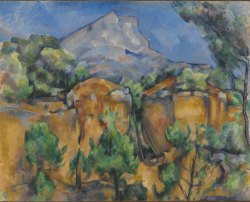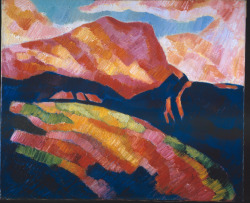Cezanne hardly ever lacks for attention, but this may be his year — especially with regard to
 his influence. Following the fabulous Cezanne and Beyond at the Philadelphia Museum of Art (which I wrote about here), the Montclair Museum of Art will open an exhibition on Sept. 13 called Cezanne and American Modernism.
his influence. Following the fabulous Cezanne and Beyond at the Philadelphia Museum of Art (which I wrote about here), the Montclair Museum of Art will open an exhibition on Sept. 13 called Cezanne and American Modernism.
The museum says it’s the first show to “examine fully the influence of Paul Cezanne (1839-1906) upon modern American artists from 1907 to 1930.” It will explore the critical way American artists and critics helped establish Cezanne’s reputation as the “definitive bridge between late 19th-century Impressionism and the modern art movements of the 20th century.”
This is a big deal for Montclair — self-proclaimed as the most ambitious show in its 95-year
 history.
history.
The exhibit includes 131 works, including 18 by Cezanne, plus paintings, works on paper, photographs, and archival documents of Oscar Bluemner, John Marin, Paul Strand, Paul Outerbridge, Man Ray, the list goes on…. After Montclair, the exhibit will travel to the Baltimore Museum of Art and the Phoenix Art Museum.
The show will recreate part of various Cezanne shows in the U.S. — the Armory Show in 1913, exhibitions at Stieglitz’s gallery 291 in 1910 and 1911, among them. Yale University Press will publish the hefty catalogue, the work of 23 scholars.
It seemed like a good time to pose Five Questions to Gail Stavitsky, Chief Curator at Montclair, the modernism expert who led the curatorial team for the show.
1) Which American modernists drew inspiration most closely from Cezanne in their artwork? Is there one in particular on whom he had the most influence?
There are 34 artists in the show and among them Marsden Hartley, Max Weber, Morgan Russell, and Maurice Prendergast are featured with the most works. If I had to pick any one artist, it would be perhaps Marsden Hartley.
2) How does this show relate to Cezanne and Beyond — where do they overlap and where do they part company?
The only overlap between the two shows is the inclusion of Marsden Hartley, Charles Demuth, and Arshile Gorky. The PMA show emphasized key European artists and later Americans such as Jasper Johns and Ellsworth Kelly. The MAM show focuses on the period 1907 to 1930 and there is more of a concentration upon including actual Cezannes that American artists would have seen in exhibitions or seen reproductions of.
This specific historical focus is best exemplified by the juxtaposition of Cezanne’s Five Apples formerly in the Stein collection with Russell’s Three Apples (1910, MoMA) which was inspired by it when Russell borrowed the Cezanne from Leo Stein.
3) The show’s theme seems, in a way, like a natural, a no-brainer — what was the biggest revelation to you as you worked on the show?
The biggest revelation was how American artists were able to find their original, unique voices through the emulation of Cezanne.
4) The exhibition covers 1907-1930. What happened after 1930 to Cezanne’s influence?
There is an essay in the catalogue that addresses the ongoing impact of Cezanne upon Abstract Expressionist artists. He remained a vital influence for many artists.
5) This is a very ambitious show for Montclair. Why now, given the economic climate, and how long has it been in the making?
The show has been ten years in the making and fortunately we were thus able to garner a lot of support for it from a variety of sources, including the NEA, the Leir and Terra Foundations, as well as the Bank of America and especially the museum’s board. The show also received Federal Indemnification as part of the new domestic program. We are very pleased to be able to present this show and to take such a positive step forward during these challenging times.
Here’s a link to the show’s press release.
Photo Credits: Cezanne, Mont Sainte-Victoire Seen From the Bibemus Quarry, c. 1897, Cone Collection, Baltimore Museum of Art, Photographer: Mitro Hood (top); Hartley, Mont Sainte-Victoire, 1927, Private Collection, Courtesy Gerald Peters Gallery (bottom)
